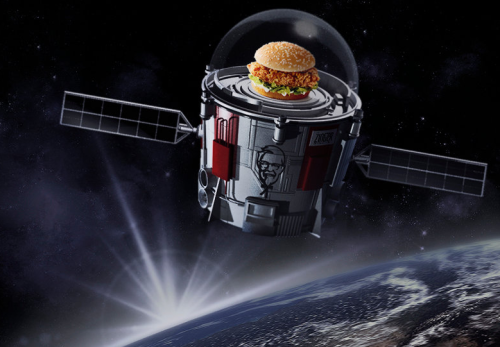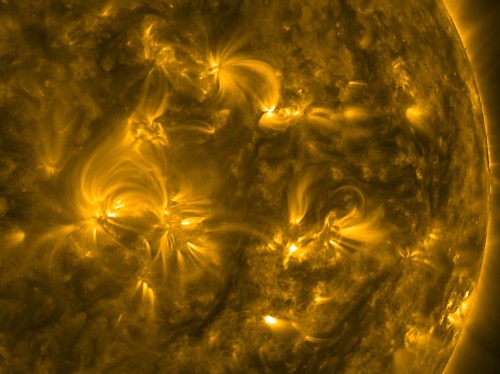Tag archives: atmospheric physics
Chicken sandwich goes stratospheric, socks for space, dressmakers have needle-sharp vision

Space sandwich: a Zinger floats high above Earth. (Courtesy: KFC)
By Sarah Tesh and Hamish Johnston
If you could put anything on a high-altitude balloon, what would it be? World View Enterprises has opted for a spicy chicken sandwich. The company plans to run balloon excursions to the stratosphere and on 21 June it will make its debut voyage carrying a Zinger sandwich from Kentucky Fried Chicken (KFC) – but with no-one on board to eat it. According to the New York Times the flight is tied in with KFC’s current space-based advertising campaign and the sandwich will spend at least four days in the stratosphere. As well as planning to charge tourists $75,000 per person for a ride, World View Enterprises says that its balloons could also be used to create an early warning system for tornadoes. (more…)
View all posts by this author | View this author's profile
Space weather: it’s all about impact
By Susan Curtis

Dangerous affair – an extreme ultraviolet image of a tangle of arched magnetic filed lines in the Sun’s corona, taken in January 2016 by NASA’s Solar Dynamics Observatory. (Courtesy: Solar Dynamics Observatory, NASA)
We all love a good disaster movie, but when it comes to real life it’s all too easy to downplay a dangerous but distant threat. Many people choose to live on active volcanoes, the citizens of San Francisco know that “the Big One” could strike at any moment, and yet they believe that the benefits of living in those locations outweigh the risk of a severe event happening in their lifetime.
The same dilemma faces the community of scientists, engineers and policy-makers who are working to understand the impacts of space weather – changes in the Earth’s environment that are largely are driven by physical processes originating from the Sun. Space weather has the potential to disrupt or even damage critical infrastructures on Earth, such as the power grids, aviation routes and communication systems that modern societies depend on, but the last notable event dates back to 2003.
That’s why Mike Hapgood, who heads up the Space Weather Group at RAL Space, part of the UK’s Rutherford Appleton Laboratory, has written a new, free-to-read Physics World Discovery ebook called Space Weather. “I thought it would be a great opportunity to highlight what space weather is really about, and to show how we are linking our scientific knowledge to a better understanding of the impacts on society,” he comments.
View all posts by this author | View this author's profile
Quantum punchlines, the cloud atlas, NASA schooled

Quantum humour: is the joke dead or alive? (Creative Commons/Benoît Leblanc)
By Sarah Tesh
You may not normally associate humour with quantum theory, but it’s not just jokes about Schrödinger’s cat and Heisenberg’s uncertainty principle that links the two. Liane Gabora of the University of British Columbia in Canada and Kirsty Kitto of Queensland University of Technology in Australia have created a new model for humour based upon the mathematical frameworks of quantum theory. The idea for their “Quantum Theory of Humour” stems from jokes like “Time flies like an arrow. Fruit flies like a banana.” Separately, the statements aren’t amusing but together they make a punchline. This requires you to hold two ideas in your head at once – a concept analogous to quantum superposition.
Pillars of light in the sky, an atomic knot and an atlas of physics
By Sarah Tesh
If I got woken in the middle of the night by my screaming child and then saw beams of light in the sky, I think I’d be worried. When Timmy Joe in Ontario saw them, however, he assumed the multi-coloured beams were the Northern Lights. Turns out they were actually caused by the extreme cold. Moisture was freezing so fast that it formed ice flakes only a few molecules thick that could float in the air. These then refracted the city lights to create a colourful light show in the night sky.
‘Chemtrails’ are a con, say experts

Vast conspiracy: contrails over Horfield Common in Bristol.
By Hamish Johnston
Is there a government-led conspiracy that uses aeroplanes to lace the atmosphere with chemicals? Of course there isn’t, and now there is a peer-reviewed study that says so.
Dubbed the “secret large-scale atmospheric programme” (SLAP), the conspiracy concerns condensation trails (contrails) that can often be seen high up in the sky. These are the lines of cloud that are formed when water condensates around particulate matter in the exhaust from jet engines. But are those contrails actually “chemtrails” that are spreading noxious substances far and wide?
The July 2015 issue of Physics World is now out
By Matin Durrani
Sometimes, nature does something unexpected – something so rare, transient or remote that only a lucky few of us get to see it in our lifetimes. In the July issue of Physics World, we reveal the physics behind our pick of the weirdest natural phenomena on our planet, from dramatic rogue waves up to 30 m tall, to volcanic lightning that can be heard “whistling” from the other side of the world, and even giant stones that move while no-one is watching. We also tackle tidal bores on rivers and the odd “green flash” that is sometimes seen at sunset.
Plus, we’ve got six fabulous full-page images of a range of weird phenomena, including salt-flat mirrors, firenadoes, “ice towers”, beautifully coloured nacreous clouds, mysterious ice bubbles of gas trapped in columns, as well as my favourite – the delicately wonderful “frost flowers” seen very occasionally on plants.
Balloon-borne experiment will reveal how cosmic rays damage computer memories
By Tamela Maciel at the APS April Meeting in Baltimore, Maryland

Little bits: the CRIBFLEX logo. (Courtesy: Drexel University Society of Physics Students)
A group of undergraduate students at Drexel University in Philadelphia is ready to click “confirm” on an Amazon order that will include a weather balloon, a memory storage device, a GPS, a Geiger counter and a BeagleBoard computer (described to me as a “beefier version of Raspberry Pi”). For less than $2000, this team of physics, engineering and computer-science students plans to launch a weather-balloon experiment that will measure the effects of cosmic rays on DRAM memory devices at high altitudes.
The team is part of the Drexel University Society of Physics Students and the members presented their experiment design at the April Meeting of the American Physical Society in Baltimore, Maryland, last weekend.
DRAM is a very quick and simple type of electronic memory – each bit takes the form of a capacitor that either has charge or doesn’t, according to whether it’s storing a zero or one. Unfortunately, this simple design can make the bits very sensitive to radioactivity or cosmic rays, which can cause bits to flip values and introduce “soft errors” into the data.
Physics of haiku, blizzards and Thor’s hammer
By Hamish Johnston
Students at Camden School for Girls in London have published a lovely book of haiku about science. Called Sciku: The Wonder of Science – in Haiku!, the volume contains 400 poems and is on sale with proceeds going to upgrading the science labs at the school. The students are not the only ones at the school with literary ambitions. Their science teacher Simon Flynn has also written a book called The Science Magpie, which we reviewed two years ago.
Below is a little taste of what is inside the book of haiku and you can also watch several of the students reading their poems in the video above.
Gravity:
An attractive force
Between all objects with mass
Just like you and me
What can superconductivity do for the environment?

Trains levitated by superconducting magnets could be in commercial service in less than 15 years (Courtesy: Shigehiro Nishijima et al.)
By Hamish Johnston
When I think of superconductivity, applications that could improve the environment don’t usually come to mind. Perhaps that’s because superconductors only work at very low temperatures and lots of energy is needed to cool them. However, a review article just published in the IOP Publishing journal Superconductor Science and Technology points out some interesting environmental applications.
Venus’ vicious vortex revealed
By James Dacey
The planet Venus may be named after the Roman god of love and beauty, but from what we know about our neighbouring planet, it appears to specialize in a particularly fiery sort of romance. It has a surface dominated by volcanism, and an atmosphere roiled by a runaway greenhouse effect, where sulphuric acid rains down amid a blitzkrieg of lightning strikes. It makes me think that the miserable sort of weather we’ve being experiencing in the UK of late is perhaps not so bad after all.
View all posts by this author | View this author's profile
